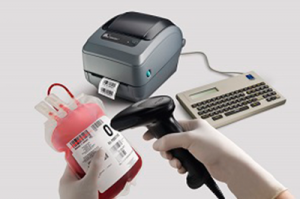Blood Tracking Solutions: The Future of Healthcare
Blood transfusions are a routine part of hospital work. Yet, in hospitals using manual systems, it’s a process riddled with the potential for error – from a lab worker accidentally mislabeling a unit of blood, to the unit having to be discarded because the nurse has been held up en route from lab to ward.
Unfortunately, sometimes mistakes aren’t discovered until the unit is at the patient’s bedside and transfusion has begun, risking the patient suffering from an adverse reaction. In 2014, 764 serious adverse events and 346 serious adverse reactions were reported to the Medicines and Healthcare products Regulatory Agency (MHRA), in the UK alone.
Additionally, blood collection is time-consuming. Lab workers start by selecting a unit from the computer system and fetching the unit from stock. Next, they print out the correct label, call the ward, and wait to place the unit into the hands of the porter or nurse. Once a call is received in the ward from the lab, a nurse or porter is notified to go to the lab, sign for the unit manually, and then head back to the ward without delay. This ensures the transfusion is carried out in line with cold chain rules. When this same process is repeated from start to finish, hundreds of times a year, the hours spent in retrieving and carrying the blood unit add up to a significant portion of working hours.
While this process might work, ultimately, it doesn’t have to be like that.
Eliminating errors through automation
Automated blood tracking solutions can slash error rates to near-zero, while simultaneously creating huge time savings.
This automated solution creates robust workflows for your teams to follow with safety checks built in every step of the way, ensuring that your patients receive the best possible care. Now, when the lab worker selects a unit of blood, that unit is given a unique identifier assigned to a particular patient. Each patient receives a different identifier, ensuring that each unit receives its rightful patient. After the unit is selected, the lab worker prints and attaches a compatibility label, which includes the patient’s name and demographic details. Then the worker takes the unit to a secure, public-facing fridge, oftentimes found in a corridor.
When the lab worker places the unit in the fridge, he or she use a mobile computer or scanner to scan the unit and the compatibility label, ensuring both are labeled correctly and accurately. Once the unit is in place, an electronic message is automatically sent, via barcode, to the ward nurse on his or her mobile device. The nurse then clicks to accept the job, goes to the fridge, and uses the barcode scanner to scan the barcode in the text message.
This unlocks the fridge automatically, while alerting the nurse where the unit of blood can be found in the fridge. The nurse then scans the unit to confirm collection, and the cold chain rules kick in. Now, if there’s a breach and the blood isn’t used within the appropriate time limit, the lab is automatically alerted.
Back on the ward, the senior nurse records a receipt using a computer on wheels. The final step is to scan both the patient’s wristband and the unit of blood: if the match is incorrect, an alert sounds so the process can be stopped. If everything is deemed okay, the transfusion can begin.
This automated solution makes absolutely sure that the blood unit being collected for each patient is the correct one. It also guarantees that only authorized personnel have access to the fridge.
Paperless, efficient and safe
While you can’t guarantee that staff will never make a mistake, this robust, automated blood tracking system makes it much harder for an error to slip through the cracks.
Furthermore, the time previously spent making phone calls, walking to and from the lab, and manually filling in labels is saved by using one seamless, paperless process that makes a blood unit’s journey from the lab to the ward as smooth as possible.
One final benefit that this automated solution offers is that it creates a complete audit trail. Each step of the unit’s journey is logged automatically, thus staff and management know who labelled and stored a particular unit, and who collected it and when they did so. Regulatory inspections become almost hassle-free; all the data you need is catalogued, saved, and searchable, so staff no longer have to wade through boxes of paper.
It’s not often that a solution can make dramatic improvements in patient safety, while improving productivity and reducing costs. Blood tracking is one example of an automated solution that does just that and hospitals typically see a return on investment within nine months. After the initial nine months, this system pays for itself many times over.


Recent Comments